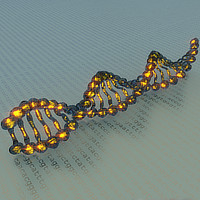Seventy-six genes linked to multisite chronic pain
Two articles on PainSci cite Johnston 2019: 1. 38 Surprising Causes of Pain 2. A Rational Guide to Fibromyalgia

PainSci commentary on Johnston 2019: ?This page is one of thousands in the PainScience.com bibliography. It is not a general article: it is focused on a single scientific paper, and it may provide only just enough context for the summary to make sense. Links to other papers and more general information are provided wherever possible.
This is the biggest study of the genetics of chronic pain patients to date, which found 76 genes that are independent risk factors for multisite chronic pain in 380,000 British citizens. Many of those genes are used in the brain and associated with neuroplasticity, and many were also linked to cell division (very fundamental biological processes). This is consistent with the idea that pain has such deep roots in our biology that it is hard to separate from life, which is why it’s so hard to suppress while also preserving consciousness.
Almost half of these genes are also risk factors for severe depression, and with some fancy statistical work they showed that pain actually causes the depression but, interestingly, not the other way around — which is probably not evidence that pain is psychologically depressing (although it is), but rather that something about the genetics of chronic pain also leads to depression.
They also found a bunch of genetic overlap with genes linked to several other diseases: schizophrenia, body-mass index, rheumatoid arthritis and post-traumatic stress disorder, among others.
original abstract †Abstracts here may not perfectly match originals, for a variety of technical and practical reasons. Some abstacts are truncated for my purposes here, if they are particularly long-winded and unhelpful. I occasionally add clarifying notes. And I make some minor corrections.
Chronic pain is highly prevalent worldwide and represents a significant socioeconomic and public health burden. Several aspects of chronic pain, for example back pain and a severity-related phenotype 'chronic pain grade', have been shown previously to be complex heritable traits with a polygenic component. Additional pain-related phenotypes capturing aspects of an individual's overall sensitivity to experiencing and reporting chronic pain have also been suggested as a focus for investigation. We made use of a measure of the number of sites of chronic pain in individuals within the UK general population. This measure, termed Multisite Chronic Pain (MCP), is a complex trait and its genetic architecture has not previously been investigated. To address this, we carried out a large-scale genome-wide association study (GWAS) of MCP in ~380,000 UK Biobank participants. Our findings were consistent with MCP having a significant polygenic component, with a Single Nucleotide Polymorphism (SNP) heritability of 10.2%. In total 76 independent lead SNPs at 39 risk loci were associated with MCP. Additional gene-level association analyses identified neurogenesis, synaptic plasticity, nervous system development, cell-cycle progression and apoptosis genes as enriched for genetic association with MCP. Genetic correlations were observed between MCP and a range of psychiatric, autoimmune and anthropometric traits, including major depressive disorder (MDD), asthma and Body Mass Index (BMI). Furthermore, in Mendelian randomisation (MR) analyses a causal effect of MCP on MDD was observed. Additionally, a polygenic risk score (PRS) for MCP was found to significantly predict chronic widespread pain (pain all over the body), indicating the existence of genetic variants contributing to both of these pain phenotypes. Overall, our findings support the proposition that chronic pain involves a strong nervous system component with implications for our understanding of the physiology of chronic pain. These discoveries may also inform the future development of novel treatment approaches.
related content
- “A functional substitution in the L-aromatic amino acid decarboxylase enzyme worsens somatic symptoms via a serotonergic pathway,” Khoury et al, Ann Neurol, 2019.
Specifically regarding Johnston 2019:
This page is part of the PainScience BIBLIOGRAPHY, which contains plain language summaries of thousands of scientific papers & others sources. It’s like a highly specialized blog. A few highlights:
- Cannabidiol (CBD) products for pain: ineffective, expensive, and with potential harms. Moore 2023 J Pain.
- Inciting events associated with lumbar disc herniation. Suri 2010 Spine J.
- Prediction of an extruded fragment in lumbar disc patients from clinical presentations. Pople 1994 Spine (Phila Pa 1976).
- Characteristics of patients with low back and leg pain seeking treatment in primary care: baseline results from the ATLAS cohort study. Konstantinou 2015 BMC Musculoskelet Disord.
- Effectiveness and cost-effectiveness of universal school-based mindfulness training compared with normal school provision in reducing risk of mental health problems and promoting well-being in adolescence: the MYRIAD cluster randomised controlled trial. Kuyken 2022 Evid Based Ment Health.